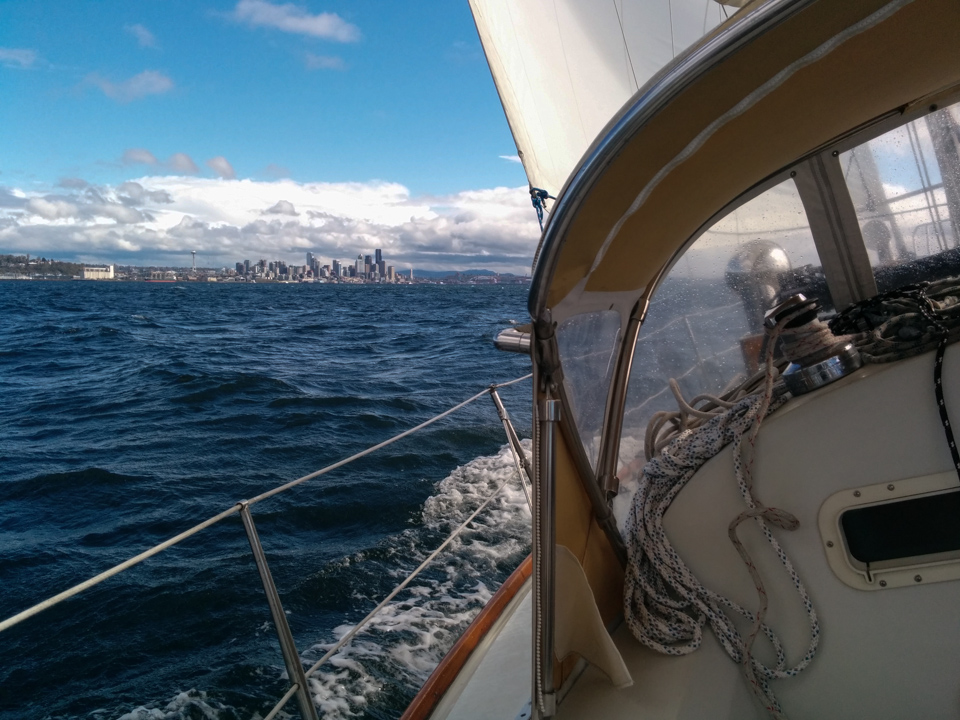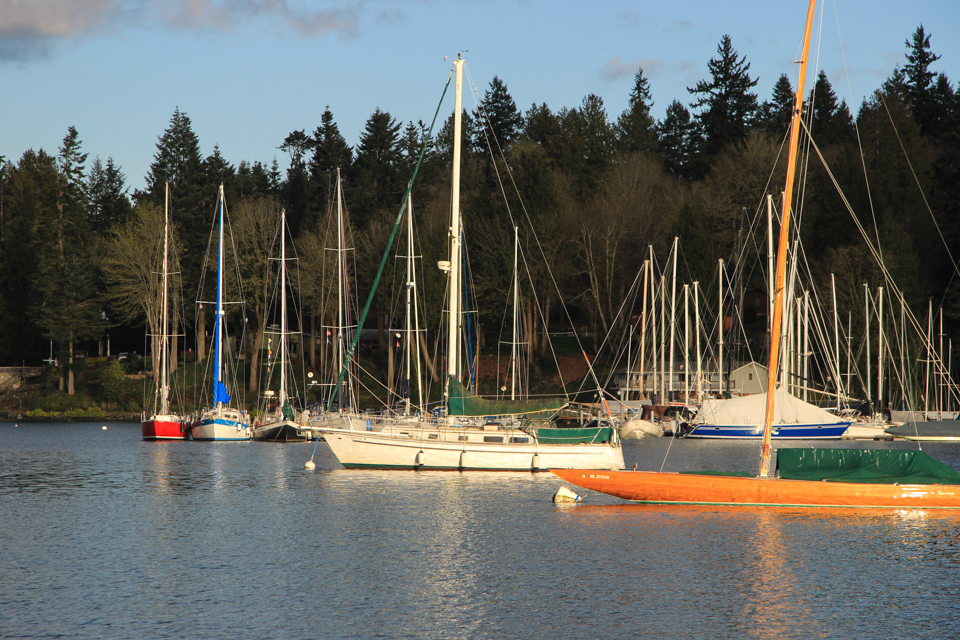Natalie and I went for our first cruise on Violet Hour this weekend. It turned out to be a really challenging one! Saturday there were high winds (24 knots) on the Sound with a small craft advisory till 3pm.
But before that the real difficulties were in the Ballard Locks. The small boat locks are closed for renovation in March, so we had to use the big locks. The big locks are exactly that – really big. They’re designed for barges and big tugboats and such. We’ve been through the small locks a few times but this was our first time going through the big locks.

Sailing on the Sound in 24 knots.
The locks had a strong 1-2 knot current flowing west out of Lake Union, and we had 10-15 knots of wind pushing us from SE as well. I think it was low tide in the Sound, and recent rains must have raised lake levels – because there were some really strong currents in and around the locks.
Waiting for the Locks to Open
We waited 20-30 minutes for the locks to open, with 2 other sailboats and 6 or 7 powerboats. When the lock operators made their announcement over the loud speaker, we couldn’t hear it over the wind. I think I heard “larger boats go first” though. We were the second to arrive, and I thought locks convention was to wait your turn and go in the order you got there (excepting commercial traffic, which there was none of). But as soon as the locks opened everyone started rushing for the entrance. The two sailboats that were after us went in before we could get there and then a motor boat cut us off but it turned out they were bailing out in order to let us go in first.
Entering the Locks
The current pushing from behind meant it was difficult to stop. We had tried to raft up to the waiting pier but even though the engine was in neutral the boat kept moving at 2 knots for 100-200 feet. I’ve dealt with current in open water before, and know what the books have to say on it – correcting for current affecting your course, speed / time to destination, etc. But never in a docking situation – most marinas don’t have any current, let alone 2 knots, unless you’re on a river.
I didn’t want to try reverse because we have pretty significant prop walk to port, and were doing starboard side docking (which is what the locks was requiring everyone do). Reversing might have thrown our stern out (but in retrospect this is what I should’ve done).
The two sailboats in front of us stopped at the end of the concrete locks pier for some reason and were being walked forward by locks operators, which meant we were running out of runway and had no operators available to help.
I decided to try stopping at the first rope bollard they have, but brought the bow in a bit too much and then when turning back out the beam rubbed into the wall. Normally that wouldn’t be a big deal, but moving at 2 knots it is – bumpers don’t work so well then, and get pushed up. We got a small scratch to the gelcoat on the hull. 🙁 Could’ve been worse though. Finally a lock operator came back and helped, as Natalie was trying her best to push the bow out from the wall as the wind and current worked on pushing the bow back in.
Exiting the Locks
After we got through the locks the railroad bridge was down, so we had to wait another 15-20 minutes for that. There were still strong currents outside the locks trying to push us towards the bridge, and a converging cross current from the outflow next to the small locks. There were two sailboats already rafted to the waiting area to enter the locks, and two sailboats waiting for the bridge with us, so it was a pretty small space to be crowded into with strong currents and wind.
It took me a while to figure out that we needed to motor in reverse to remain relatively stationary, and definitely should not get in the converging current which started to spin us. Since there wasn’t much space, this meant motoring back up into the locks a bit, which another sailboat was also doing.
I also learned you really don’t want to try to do a standing turn while 2 knots of current is pushing you towards the bridge. Light forward throttle just accelerated our slide towards the bridge, and I had visions of a YouTube video I’d seen where a sailboat crashed into a bridge and got their mast and rigging swept under. I quickly went back to motoring only in reverse.
In Conclusion
The big locks passages took us 1 to 1 1/2 hours each, and a lot of stress. I can see why sailboats prefer to be moored outside the locks on the Sound. Oh well, now I have one more thing to add to my list for the Defender.com sale that starts this Thursday (Evercoat Gelcoat Repair Kit).

Anchored in Port Madison
Other than the locks the trip was great. Sailing in 24 knots was great fun – although tiring and we’re still getting to know the boat, so some tweaking is definitely needed for these higher wind conditions. Going upwind, one bow wave crashed past the dodger and soaked me with cold Puget Sound water, which got me laughing. Going downwind we were surfing down waves (2-4 foot waves) at 7.3 knots peak speed, with one reef in the main and genoa furled to about 120%.
And our anchoring setup worked splendidly even though I haven’t done any work on it yet.

Yummy dinner of baked salmon and asparagus risotto.

You can see the stars from Port Madison!
[youtube=http://youtu.be/pcmfvIz4Egs?hd=1&vq=hd720]
